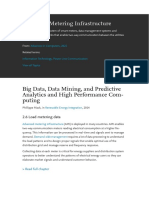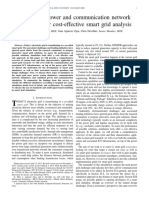Massoud Amin On Costs and Benefits of Smart Grid Technologies
Massoud Amin On Costs and Benefits of Smart Grid Technologies
Uploaded by
Massoud AminCopyright:
Available Formats
Massoud Amin On Costs and Benefits of Smart Grid Technologies
Massoud Amin On Costs and Benefits of Smart Grid Technologies
Uploaded by
Massoud AminOriginal Description:
Original Title
Copyright
Available Formats
Share this document
Did you find this document useful?
Is this content inappropriate?
Copyright:
Available Formats
Massoud Amin On Costs and Benefits of Smart Grid Technologies
Massoud Amin On Costs and Benefits of Smart Grid Technologies
Uploaded by
Massoud AminCopyright:
Available Formats
Massoud Amin on Costs and Benefits of Smart Grid Technologies
. Smart grid technologies represent varied ways to improve the effectiveness of the power distribution
and transmission system by making it potential to use existing power infrastructure more competently.
Implementation of smart grid solutions can for instance, represent an option to investment in new
power generation capacity or new power lines.
Several new smart grid technologies are available, but not yet deployed. In order to advance
implementation, investors and governments need decision support to assess investments in smart grid
technologies. Cost-benefit analysis (CBA) offers a methodical procedure for comparing the advantages
and disadvantages of a smart grid initiative from society viewpoint.
This report presents a mapping and analysis of present literature on social costs and advantages of
smart grid solutions and identifies gaps in present guidance. The study also comprises a review on how
network regulation affects incentives to invest in smart grid technologies and an investigation on how
CBA constitutes an imperative input to the design of the network regulation. The report also serves as a
basis for choosing models and methods to be used by the Smart Grid Forum in order to review different
smart grid projects and applications.
Due to the broad and multifaceted nature of smart grid technologies, CBA of smart grid deployment is
difficult as smart grid technologies provide benefits on a system level in addition to on the project level.
Smart grid technologies are also under fast development, which result in a lack of data and uncertainty
when extrapolating results from lead projects to the system level.
Energy and climate objectives as those identified on the European level as well as on national levels aim
to augment renewable energy, perk up energy efficiency and decrease carbon emissions. Smart grid
technologies contribute to all these goals, not only straightforwardly but to large extent in a roundabout
way, which calls for wide-ranging evaluation methodologies on a system level. Comprehensive analyses
on the system level can offer input to CBA.
Given the intricacy and the multiple challenges that can occur such as the results of severe weather
conditions, human sabotage, damage by wildlife, and other external factors and internal
factors managing a grid is very difficult and a devoted field for experts who also need to think about the
choices regarding energy regulations and initiatives by governments.
The two-way flow of electricity and data according to Massoud Amin that is the essential characteristic
of a smart grid allows to feed information and data to the several stakeholders in the electricity market
which can be analyzed to optimize the grid, foresee potential issues, react quicker when challenges arise
and build new capacities and services as the power landscape is changing
You might also like
- 3D Printing Failures 2022 Edition How To Diagnose and Repair ALL Desktop 3D Printing Issues (Sean Aranda)Document660 pages3D Printing Failures 2022 Edition How To Diagnose and Repair ALL Desktop 3D Printing Issues (Sean Aranda)Anti Sora100% (18)
- Visvesvaraya Technological University Internship ReportDocument25 pagesVisvesvaraya Technological University Internship ReportBaibhav Kumar100% (5)
- Case 9 1Document2 pagesCase 9 1Jessica Tjan80% (5)
- Full Report On "VEHICLE TO GRID TECHNOLOGY (V2G) "Document35 pagesFull Report On "VEHICLE TO GRID TECHNOLOGY (V2G) "Rahul Garg67% (3)
- ITP For False Ceiling Works of BuildingsDocument4 pagesITP For False Ceiling Works of BuildingsYay B. Gico0% (1)
- EA ManualDocument13 pagesEA Manualmangelbel6749100% (2)
- Transformative Agents of Positive ChangeDocument7 pagesTransformative Agents of Positive ChangestephenraghunathNo ratings yet
- The Utility of The Future WPDocument4 pagesThe Utility of The Future WPbartee000No ratings yet
- David Mark, Ken Ostrowski, and Humayun Tai: The Forces of ChangeDocument2 pagesDavid Mark, Ken Ostrowski, and Humayun Tai: The Forces of ChangeOnwuntaNo ratings yet
- Illiterure - Review & Quantetive Data 2Document7 pagesIlliterure - Review & Quantetive Data 2Redowan A.M.RNo ratings yet
- M Tech Thesis On Smart GridDocument8 pagesM Tech Thesis On Smart Gridpbfbkxgld100% (2)
- 2020 Smart Grid System Report - 0Document165 pages2020 Smart Grid System Report - 0montaserNo ratings yet
- Evaluation of Smart Grid Technologies Based On Decision Support SystemDocument6 pagesEvaluation of Smart Grid Technologies Based On Decision Support SystemKIU PUBLICATION AND EXTENSIONNo ratings yet
- Evaluation of Smart Grid Technologies Based On Decision Support SystemsDocument7 pagesEvaluation of Smart Grid Technologies Based On Decision Support SystemsUnknown BeingNo ratings yet
- Smart Grid Literature ReviewDocument4 pagesSmart Grid Literature Reviewafdtygyhk100% (1)
- Thesis Smart GridDocument8 pagesThesis Smart GridAmy Cernava100% (2)
- Thesis Paper On Smart GridDocument7 pagesThesis Paper On Smart Gridshannonsandbillings100% (2)
- SMB/5190/R: Strategic Business Plan (SBP)Document7 pagesSMB/5190/R: Strategic Business Plan (SBP)Hernando RomeroNo ratings yet
- Research Papers On Smart Grid TechnologyDocument4 pagesResearch Papers On Smart Grid Technologynepwuhrhf100% (1)
- Smart Transmision Grid in EuropeDocument36 pagesSmart Transmision Grid in EuropeFernando PatiñoNo ratings yet
- A Knowledge Management Platform For Supporting Smart Grids Based On Peer To Peer and Service Oriented Architecture TechnologiesDocument6 pagesA Knowledge Management Platform For Supporting Smart Grids Based On Peer To Peer and Service Oriented Architecture TechnologiesfkazasisNo ratings yet
- 1 s2.0 S1364032116304191 MainDocument18 pages1 s2.0 S1364032116304191 MainthomasfebyantoNo ratings yet
- Getting SmartDocument8 pagesGetting SmartOld14No ratings yet
- Power System Design - Basis For Efficient Smart Grid InitiativesDocument1 pagePower System Design - Basis For Efficient Smart Grid InitiativesShowren RudraNo ratings yet
- Smart Grids: Under The Esteem Guidance of MR - Srinath SirDocument7 pagesSmart Grids: Under The Esteem Guidance of MR - Srinath SirSubhashini Pulathota0% (1)
- 1 s2.0 S0142061514003743 Main PDFDocument12 pages1 s2.0 S0142061514003743 Main PDFSamuel TesfayNo ratings yet
- SMART GRID Seminar ReportDocument21 pagesSMART GRID Seminar ReportPriyankaNo ratings yet
- 2010 Jul Smart GridsDocument0 pages2010 Jul Smart GridshafizgNo ratings yet
- Smart GridDocument84 pagesSmart GridMUHAMMAD ASIMNo ratings yet
- 2013 Grid Modernization IndexDocument24 pages2013 Grid Modernization IndexJaime A. SánchezNo ratings yet
- Smart Grid Conference 05 13 2009Document12 pagesSmart Grid Conference 05 13 2009Irodov IlizarovNo ratings yet
- Smart Grid and Optimization: Murat Ahat, Soufian Ben Amor, Marc Bui, Alain Bui, Guillaume Guérard, Coralie PetermannDocument11 pagesSmart Grid and Optimization: Murat Ahat, Soufian Ben Amor, Marc Bui, Alain Bui, Guillaume Guérard, Coralie PetermannAbhit SinghNo ratings yet
- An Extensive Critique On Smart Grid Technologies: Recent Advancements, Key Challenges, and Future DirectionsDocument2 pagesAn Extensive Critique On Smart Grid Technologies: Recent Advancements, Key Challenges, and Future DirectionsvarmaNo ratings yet
- The Smart Grid: Frequently Asked Questions For State CommissionsDocument7 pagesThe Smart Grid: Frequently Asked Questions For State CommissionsGyana Ranjan KarNo ratings yet
- Smart Grid: The Future of The Electric Energy System Roger N. Anderson1, IEEE Member, Reza Ghafurian2, IEEE Fellow, Hamid Gharavi3, IEEE FellowDocument2 pagesSmart Grid: The Future of The Electric Energy System Roger N. Anderson1, IEEE Member, Reza Ghafurian2, IEEE Fellow, Hamid Gharavi3, IEEE FellowvarmaNo ratings yet
- A Generic Framework For The Evaluation of The BeneDocument21 pagesA Generic Framework For The Evaluation of The BeneRicardo Vash LázaroNo ratings yet
- Smart Grid Technology Research PapersDocument8 pagesSmart Grid Technology Research Paperscafjhhaj100% (1)
- Smart Grid 1187 2707 1 SMDocument11 pagesSmart Grid 1187 2707 1 SMmanjusingNo ratings yet
- Waht Is Smart GridDocument5 pagesWaht Is Smart Gridworldcreators2_79758100% (1)
- 23 SmartDocument2 pages23 SmartLuis BasilioNo ratings yet
- Smart Grids and Demand Response: Conceptual Review: September 2019Document18 pagesSmart Grids and Demand Response: Conceptual Review: September 2019Navtesh AroraNo ratings yet
- Market Based Transmission Expansion Planning: Stakeholders' DesiresDocument6 pagesMarket Based Transmission Expansion Planning: Stakeholders' Desiresapi-3697505No ratings yet
- Research Papers On Smart GridDocument5 pagesResearch Papers On Smart Gridfvfj1pqe100% (1)
- 10 35378-Gujs 554206-1121835Document19 pages10 35378-Gujs 554206-1121835Nahil ShakerNo ratings yet
- Enabling Smart GridDocument12 pagesEnabling Smart Gridamiraj01No ratings yet
- Term Project Report: Big Data and Smart Grid: Scope For Indian Power SectorDocument14 pagesTerm Project Report: Big Data and Smart Grid: Scope For Indian Power SectorAvani PatelNo ratings yet
- Smart Contracts in Energy Systems: A Systematic Review of Fundamental Approaches and ImplementationsDocument28 pagesSmart Contracts in Energy Systems: A Systematic Review of Fundamental Approaches and ImplementationsandreaNo ratings yet
- Transformation and Future Trends of Smart Grid Using Machine and Deep Learning: A State-Of-The-Art ReviewDocument11 pagesTransformation and Future Trends of Smart Grid Using Machine and Deep Learning: A State-Of-The-Art ReviewInternational Journal of Applied Power EngineeringNo ratings yet
- Introduction To Smart GridDocument6 pagesIntroduction To Smart GridRavinder RangaNo ratings yet
- 10 0000@www Researchgate Net@280204252Document21 pages10 0000@www Researchgate Net@280204252MohamedKadryNo ratings yet
- 5.a Conceptual Framework For Smart GridDocument4 pages5.a Conceptual Framework For Smart GridpaulshuvaNo ratings yet
- Smart Grid Research Paper Summary 16783Document1 pageSmart Grid Research Paper Summary 16783Muhammad RizwanNo ratings yet
- 6.WhitePaper Comm Tech Networks For SmartGrid SmartMeteringDocument13 pages6.WhitePaper Comm Tech Networks For SmartGrid SmartMeteringSiddharth Jain 16BEE0276No ratings yet
- Research Papers Related To Smart GridDocument6 pagesResearch Papers Related To Smart Gridyhclzxwgf100% (1)
- Energies 07 02377 PDFDocument44 pagesEnergies 07 02377 PDFmakmohit6037No ratings yet
- Role of Communications in SmartgridDocument4 pagesRole of Communications in SmartgridChaitu ChaitanyaNo ratings yet
- Smart GirdDocument9 pagesSmart GirdVijay ReddyNo ratings yet
- IET Educational (Stephanie Hay) PDFDocument13 pagesIET Educational (Stephanie Hay) PDFAsim IhsanNo ratings yet
- AMI TechnologyDocument14 pagesAMI TechnologyZubab PanniNo ratings yet
- Smart Metering: July 2006Document9 pagesSmart Metering: July 2006litriumtechNo ratings yet
- Energies 06 03593Document29 pagesEnergies 06 03593Aditya DasNo ratings yet
- Smart GridDocument2 pagesSmart GridTAVE TADEONo ratings yet
- Combining Power and Communication Network Simulation For Cost-Effective Smart Grid AnalysisDocument25 pagesCombining Power and Communication Network Simulation For Cost-Effective Smart Grid AnalysisFrancisco GoncastNo ratings yet
- 12 Future GridDocument4 pages12 Future Gridbobocel_alexandru32No ratings yet
- Innovation Landscape brief: BlockchainFrom EverandInnovation Landscape brief: BlockchainNo ratings yet
- CONMAC Machinery Cone Crusher: Operating ManualDocument41 pagesCONMAC Machinery Cone Crusher: Operating ManualFredy QuispeNo ratings yet
- YT 1600H User Manual enDocument28 pagesYT 1600H User Manual enjanwarahmad78No ratings yet
- Computational Health in For Matics For Biomedical ApplicationsDocument78 pagesComputational Health in For Matics For Biomedical ApplicationsGaurav UpaNo ratings yet
- RTL8304MBDocument49 pagesRTL8304MBcclservice99No ratings yet
- RadiSys EPC 6A ManualDocument74 pagesRadiSys EPC 6A ManualRashid AzamNo ratings yet
- Tangential Method CalculationDocument7 pagesTangential Method CalculationHeberth DesbloqueoNo ratings yet
- Eng - Mostafa AlhussienyDocument3 pagesEng - Mostafa AlhussienySasa BasNo ratings yet
- Ah en PC Worx FDCML 107756 en 01Document2 pagesAh en PC Worx FDCML 107756 en 01DERRIC JOSEPHNo ratings yet
- Service Marketing of Automobile IndustryDocument23 pagesService Marketing of Automobile Industrysumanvish88No ratings yet
- 1266 - Teleradiology (2008)Document301 pages1266 - Teleradiology (2008)rasyidNo ratings yet
- Challenger 650Document14 pagesChallenger 650Saniya ShaikhNo ratings yet
- Tag Attribute.: Html-I Basic HTML ElementsDocument47 pagesTag Attribute.: Html-I Basic HTML ElementsAman GuptaNo ratings yet
- Warning: Asm170 Murphymatic Micro-Controller Installation and Operation InstructionsDocument4 pagesWarning: Asm170 Murphymatic Micro-Controller Installation and Operation InstructionsSuryadiNo ratings yet
- Voltage Influence On Typical Protection and Controls ForDocument22 pagesVoltage Influence On Typical Protection and Controls ForM Kumar MarimuthuNo ratings yet
- Chandigarh UniversityDocument10 pagesChandigarh UniversityTANUDEEP SINGHNo ratings yet
- 998-21202068 SquareD EasyUPS LMA USA Brochure Letter DIGITAL-HIGHDocument8 pages998-21202068 SquareD EasyUPS LMA USA Brochure Letter DIGITAL-HIGHJesus Enrique AnayaNo ratings yet
- XL4016 DatasheetDocument10 pagesXL4016 DatasheetARTMehr Eng. GroupNo ratings yet
- 05 CapacitorDocument7 pages05 CapacitorJoven Andrei R. LagahitNo ratings yet
- ADT Security-Medium and Large BizDocument7 pagesADT Security-Medium and Large BizaeaneaNo ratings yet
- 2.existing System 3.proposed System 5. Uml Diagram 6. System Anaysis 7. Hardware and Software Specification 8. Implementation Conclusion ReferencesDocument33 pages2.existing System 3.proposed System 5. Uml Diagram 6. System Anaysis 7. Hardware and Software Specification 8. Implementation Conclusion ReferencesThareesh BabuNo ratings yet
- Oracle Service On Windows ClusterDocument21 pagesOracle Service On Windows ClusterLeighton FordNo ratings yet
- ASC ZR (T) 160-900 VSD Tab04 Commissioning Procedure 2946 0282 02Document9 pagesASC ZR (T) 160-900 VSD Tab04 Commissioning Procedure 2946 0282 02Leonardo SilvaNo ratings yet
- BM 17200 Brake Roller TesterDocument2 pagesBM 17200 Brake Roller TesterNurhalisa AksaNo ratings yet
- Experiment With AR-DV10Document1 pageExperiment With AR-DV10Moreno WedNo ratings yet

























































































